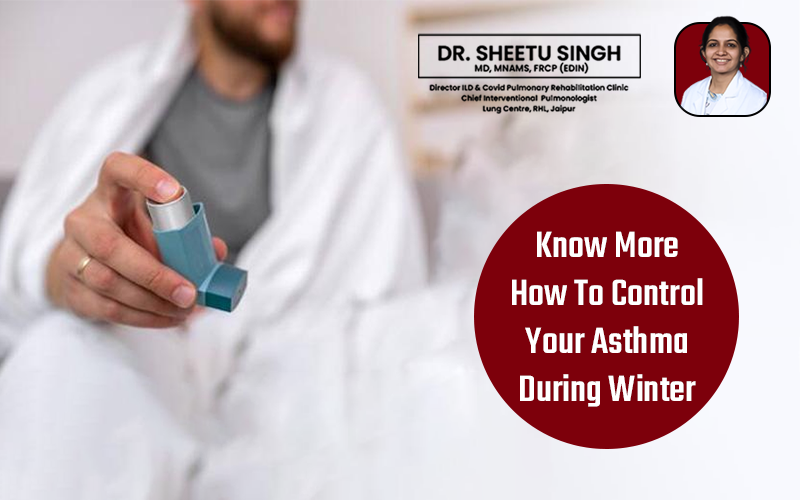
Know More How To Control Your Asthma During Winter: Winter is not kind to asthma patients. Asthma symptoms are usually worse when the air is cold and dry. Apart from cold weather triggering asthma symptoms in the airways and seasonal sickness causing asthmatic attacks, this time is characterized by a unique set of challenges that must be dealt with. Although winter can be tough on your lungs, with some thoughtful preparation and disciplined self-care, you can get through the cold months feeling healthy and breathing freely.
This article presents proven ways of safeguarding against asthma attacks during cold weather season and provides tips that help you recognize symptoms before they become a medical emergency. Equipment yourself with the right information and the preventive measures so that asthma does not turn out to be more threatening than the joy of wintertime
How Winter Impacts Asthma
Several factors during the colder months can instigate asthma symptoms or exacerbate existing issues:
- Dry Air
Heating systems used during the winter months reduce indoor air humidity. Dry air readily crosses inflamed airway linings and evaporates residual moisture from delicate lung tissues. This leaves the bronchioles dried out and increasingly sensitive to inhaled particles or gasses. Nerve endings exposed by dried-out linings then trigger bronchoconstriction when confronted by asthma triggers.
- Cold Air
Inhaled cold air chills the bronchial tubes, provoking spasmodic constriction of the smooth muscle in their walls. This exacerbates existing airway inflammation and causes transient narrowing of the air paths. Labored breathing, wheezing, chest tightness and shortness of breath results. The degree of airway cooling depends on the temperature and humidity levels outdoors, an individual’s breathing rate and volume, and use of scarves or masks to warm inhaled air before it enters the lungs.
- Physical Changes
Studies show that beyond transient bronchospasm from cold exposure, inhaled frigid and dry air can promote physical remodeling of asthmatic airways over weeks to months. This aggravates their intrinsically hyperresponsive state. Specific structural changes include increased mucus secretion, inflammation damage to critical cilia and submucosal glands, and airway wall thickening.
- Illnesses
Viral respiratory illnesses like colds and flu increase in incidence during winter months. The airway inflammation produced by these infections heightens sensitivity and constricts bronchioles. This significantly amplifies asthma symptoms and difficulty breathing.
- Exercise
Vigorous exertion outdoors in cold, dry atmospheric conditions strains the airways via both weather and activity-related mechanisms. The increased breathing rate and oxygen demand challenge already inflamed bronchioles. Respiratory droplets also readily freeze into breath, exacerbating airway irritation.
Tips To Ease Winter Asthma Problems
While the cold poses inevitable challenges, you can dampen its impact through attentive self-care:
1. Environmental Modifications
Checking daily weather forecasts allows individuals to anticipate and prepare for shifts in temperature, precipitation or humidity levels that may impact their asthma. Using indoor humidifiers can help restore moisture to extremely dry household air. Covering one’s nose and mouth with a scarf or mask when going outside allows the inhaled air to warm to near body temperature before entering the airways. This prevents bronchospasm triggered by cold air. Remaining vigilant for mold growth and undertaking cleaning or moisture reduction when necessary also helps control the home environment. Asthma sufferers should aim to spend time outdoors only when conditions are unlikely to trigger attacks.
2. Preventative Medical Interventions
Obtaining a yearly influenza vaccination helps patients avoid inflammatory respiratory illnesses. Patients should discuss adding preventative, anti-inflammatory medications with their doctors to reduce inflammation. Having fast-acting bronchodilator rescue medications easily available allows immediate intervention at the first signs of an asthma attack. This rapid airway smooth muscle relaxation can prevent severe escalation of symptoms.
3. Avoidance of Specific Triggers
- Steer clear of known personal asthma instigators like smoke, pets, dust, etc.
- Abstain from vigorous outdoor exercise given weather risks; opt for indoor physical activity
- Wash hands frequently and avoid interacting closely with obviously sick individuals
- Note specific activities, exposures, or diet choices that seem to prompt winter attacks and prevent recurrences
4. Symptom Logging
- Carefully track lung health during winter, noting:
- Frequency of rescue bronchodilator use
- The presence of nocturnal coughing or awakening
- Decreased exercise tolerance
- Wheezing, chest tightness, shortness of breath
- Promptly communicate symptom elevations to the treating physician
Warning Signs
Being ultra-aware of subtle asthma shifts allows you to intervene with medication before severe attacks arise. Warning signs to heed include:
- Increased use of quick-relief inhaler
- More frequent cough, especially at night
- Feeling winded doing regular activities
- Chest tightness, pressure or pain
- Audible wheezing without a cold
Consult Asthma Specialist
If the cold season persistently plagues your asthma no matter how vigilantly you self-manage, it may be wise to partner with an expert for customized care. Asthma specialist Dr Sheetu Singh offers extensive experience designing tailored treatment regimens to help patients effectively control their disease all winter long.
After thoroughly assessing your medical history, prior exacerbations, and current control status, Dr Sheetu Singh will provide a strategic plan just for you. This may incorporate adjustments to controller or rescue medications to dial in the optimal doses and timing for defeating winter asthma flare-ups. If symptoms arise despite prevention, Dr Sheetu Singh also excels at rapidly identifying causes and adjusting therapies to get asthma back into a healthy range again. Don’t let winter uncertainties leave you breathless – have Dr Sheetu Singh in your corner!
